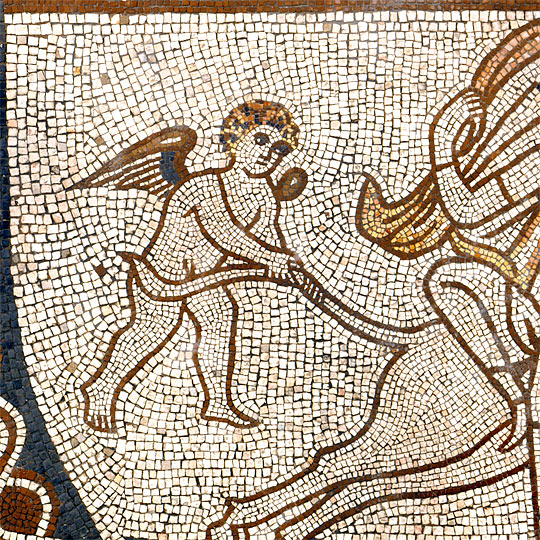Significance of Lullingstone Roman Villa
The significance of Lullingstone primarily derives from the importance of the Christian evidence from the site – the least equivocal from any Roman site in Britain. The preservation of elements of the structure of the villa-house is also exceptional, particularly the mosaic floors, which raise questions about the intentions, beliefs and background of the owners.

A Rare House-Church
The evidence of the Christian house-church is a unique discovery for Roman Britain and the wall paintings are of international importance. Not only do they provide some of the earliest evidence for Christianity in Britain, but they are also almost unique. The closest parallels come from a house-church in Dura Europus, Syria.
These paintings represent an overt and unequivocal statement of Christianity by Lullingstone’s owners. Persecution of Christians officially ceased in the Roman Empire after the adoption of Christianity by the Emperor Constantine in AD 313.
The fact that the paintings date from some 40 years after this could be explained in a number of ways. The owners of Lullingstone may not have adopted Christianity until well after it was officially accepted.
Alternatively, while the Bellerophon mosaic illustrates a well-known myth, at Lullingstone it may also have been intended as an allegory for the triumph of good over evil and, as the mosaic could pre-date the house-church by a few years, it could be a Christian-inspired message disguised as an expression of classical learning.
The Europa Inscription
Debate still surrounds the intentions behind the inscription associated with the Europa mosaic. It has been suggested[1] that it hides the villa owner’s name, which could be Avitus (starting with the last letter of the first word, and then taking every seventh letter to the end of Aeolias); or, more intriguingly, that it contains a covert reference to Jesus (starting with the first letter in the second line, and then taking every eighth letter and the final letter of the inscription).
If the mosaic is broadly of the same date as the house-church, it would seem strange that a reference to Jesus would be so disguised, but it could be a way of imposing a Christian message on a pagan scene.
Another possibility is that like the Bellerophon pavement, the Europa mosaic could pre-date the house-church by about ten years, before the owner came out openly as a Christian.
If the mosaics do contain coded Christian inscriptions and messages, it could be that Christians at Lullingstone feared the return of the old habits of intolerance and persecution, despite Constantine’s sanctioning of their religion, and so preferred to worship covertly for a time. Had the brief resurgence of paganism under Julian ‘the Apostate’, Emperor from 355 to 363, been sustained, such caution might have been seen as shrewd.
Polytheism
Perhaps almost as remarkable as the discovery of the house-church is the possibility that pagan worship may have continued in the cult room below it.
What is not clear is whether this represented the family hedging their bets, trumpeting their apparent acceptance of Christianity, while trying to keep the old gods happy, or whether it represents some members of the family clinging to old beliefs in the face of the adoption of Christianity by others.
Alternatively, it might represent an expression of traditional Roman pragmatic polytheism, which accommodated a variety of gods. Such an attitude, however, would have been unacceptable to genuinely devout Christians, whose refusal to acknowledge other gods had been a major factor in their persecution, as it was for the Jews.
The wall painting in the cult room is a rare and important treasure in itself, not only for its age – it is by far the earliest wall painting in English Heritage’s care – but also for the fact that it has survived in situ. This is very rare for excavated Roman wall paintings, especially in England.
Footnote
1. M Henig, ‘The secret of the Lullingstone mosaic’, Kent Archaeological Review, 139 (2000), 196–7; see also printer’s corrections to Henig’s paper in Kent Archaeological Review, 140 (2001), 219.